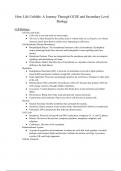How Life Unfolds: A Journey Through GCSE and Secondary Level
Biology
Cell Biology:
Cell Size and Scale:
● Cells vary in size but most are microscopic.
● The size is often dictated by the surface area to volume ratio; as a cell grows, its volume
increases much faster than its surface area, impacting its efficiency.
Cell Membrane (Plasma Membrane):
● Phospholipid Bilayer: The foundational structure of the cell membrane. Hydrophilic
(water-attracting) heads face outward, and hydrophobic (water-repelling) tails face
inward.
● Membrane Proteins: These are integrated into the membrane and play roles in transport,
signaling, and maintaining cell shape.
● Fluid Mosaic Model: Describes the cell membrane as a dynamic structure with proteins
drifting in the lipid bilayer.
Organelles:
● Endoplasmic Reticulum (ER): A network of membranes involved in lipid synthesis
(smooth ER) and protein synthesis (rough ER, which has ribosomes).
● Golgi Apparatus: Processes and packages proteins for secretion or transport to other parts
of the cell.
● Mitochondria: Often called the "powerhouse of the cell" because they produce ATP, the
cell's energy currency, through cellular respiration.
● Lysosomes: Contain digestive enzymes that break down waste materials and cellular
debris.
● Peroxisomes: Break down fatty acids and detoxify certain chemicals.
● Centrosomes and Centrioles: Play a key role in cell division in animal cells.
Nucleus:
● Nuclear Envelope: Double membrane that surrounds the nucleus.
● Nucleolus: Dense structure in the nucleus where ribosomal RNA (rRNA) is synthesized.
● Chromatin: DNA and proteins that make up chromosomes.
Cell Cycle:
● Interphase: Period of cell growth and DNA replication; comprises G1, S, and G2 phases.
● Mitosis: Division of the nucleus; comprises prophase, metaphase, anaphase, and
telophase.
● Cytokinesis: Division of the cytoplasm.
Endomembrane System:
● A group of organelles and membranes in eukaryotic cells that work together to modify,
package, and transport lipids and proteins. Includes the nuclear envelope, lysosomes,
vesicles, ER, and Golgi apparatus.
Cellular Transport:
, ● Passive Transport: Does not require energy. Includes diffusion, osmosis, and facilitated
diffusion.
● Active Transport: Requires energy (ATP) to move molecules against a concentration
gradient.
● Endocytosis and Exocytosis: Bulk transport mechanisms to take in (endocytosis) or expel
(exocytosis) large molecules.
Cell Differentiation:
● The process by which a cell becomes specialized to perform a specific function. Stem
cells have the potential to become any type of cell in the organism.
Cell-to-Cell Communication:
● Hormone Signaling: Hormones released from a cell affect other cells in the body.
● Neurotransmitter Signaling: Neurotransmitters are released from neurons to send signals to
adjacent neurons or muscle cells.
● Direct Cell-to-Cell Contact: Through structures like gap junctions in animals or plasmodesmata in
plants.
Prokaryotic Cells vs. Eukaryotic Cells:
● Prokaryotic: Smaller, simpler, no nucleus, and no membrane-bound organelles. Examples:
bacteria and archaea.
● Eukaryotic: Larger, complex with a nucleus, and have membrane-bound organelles. Examples:
plants, animals, fungi, and protists.
Human Biology:
Basic Building Blocks:
● Cells: The fundamental unit of life. Different cell types include muscle cells, nerve cells,
and blood cells.
● Tissues: Groups of similar cells working together, like epithelial, connective, muscle, and
nervous tissue.
● Organs: Structures composed of multiple tissue types performing specific functions. E.g.,
heart, liver, and lungs.
● Organ Systems: Groups of organs working together to accomplish complex functions.
Integumentary System:
● Comprises the skin, hair, and nails.
● Offers protection, regulates temperature, and provides sensory information.
Skeletal System:
● Comprises bones and joints.
● Provides structural support, facilitates movement, and produces blood cells.
Muscular System:
● Encompasses skeletal, smooth, and cardiac muscles.
● Enables movement, maintains posture, and produces heat.
Nervous System:
● Central Nervous System (CNS): Consists of the brain and spinal cord. Processes and
transmits information.
● Peripheral Nervous System (PNS): All nerves outside the CNS. Transmits information to
and from the CNS.




